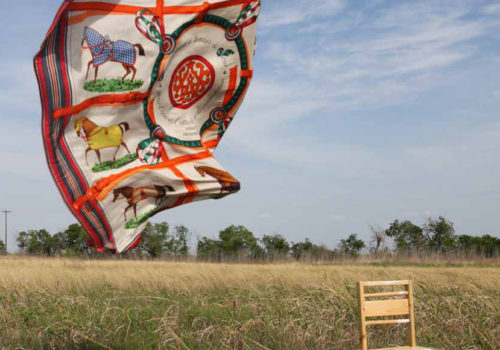The Austin-based artist William Hundley, 35, has the peculiar habit of tossing up cloths, sheets, drapes, blankets, scarves, tarps, etc., and photographing the ephemeral airborne sculpture (which last some hundredths of a second) before it lands.
Entoptic Phenomena is the original series by Hundley, an artist influenced by the work of absurdists like Erwin Wurm and his One minute sculptures, and the post-Duchampian Maurizio Cattelan. “I love the practical-joke nature of it,” says Hundley. “If I can make humor and beautiful aesthetics come together, that’s the biggest powerhouse I can imagine.”
Hundley is a member of the generation of young artists that resist defining themselves as such. They blend photography, sculpture, painting and video, defy the standard artistic discourse, play freely with the raw and incongruous, endow contemporary objects with a tribal character and question the direction and meaning of art.
Claiming that anyone else would have been equally qualified to answer the interview questions, Hundley describes himself as a typical young man with a normal life. He works in his daily surroundings: the street, at home and with his friends, as in his series Friends, Things I do in my garage, Little Naked Person Storage, w/ cheeseburgers, masquerading as normal but using that normalcy as a springboard to something else.
Winner of the jury prize at the Texas Biennial 2007 and standout artist in Austin, Hundley has had solo shows in Seattle, Los Angeles, Berlin, Austin and Toronto, and taken part in group shows across the world. Apart from Entoptic Phenomena, begun in 2006, his work work went viral in 2008 with his series w/ cheeseburgers and the “Chihuahua on Cheeseburgers” photograph.
His ideas also inspired music video for Charlotte Gainsbourg and Beck’s “Heaven Can Wait,” directed by Keith Schofield.
Hundley’s work has been widely published. In 2010, Magazine dedicated a feature to Entoptic Phenomena.
Fred Rawyler and Stéphane Wargnier, artistic director and editor-in-chief of the magazine Le Monde d’Hermès, spotted his work and invited Hundley to shoot a similar series with Hermès famous scarves.
Although Hundley usually forgoes commercial work, he was seduced by the Hermès universe and the freedom he would be allowed for this project. After discussing the details of the project on the phone, Hundley received the scarves in the mail. The result is both beautifully executed and respectful of the rhythm an artist’s process.
“Every image that Fred Rawyler and I received was another opportunity to discover yet another aspect of William’s imagination,” says Stéphane Wargnier, “which is a rather delightful way to work!”
The series can be seen in the Autumn-Winter 2011 issue of Le Monde d’Hermès, available in Hermès stores through February.
Séverine Morel
[email protected]
















